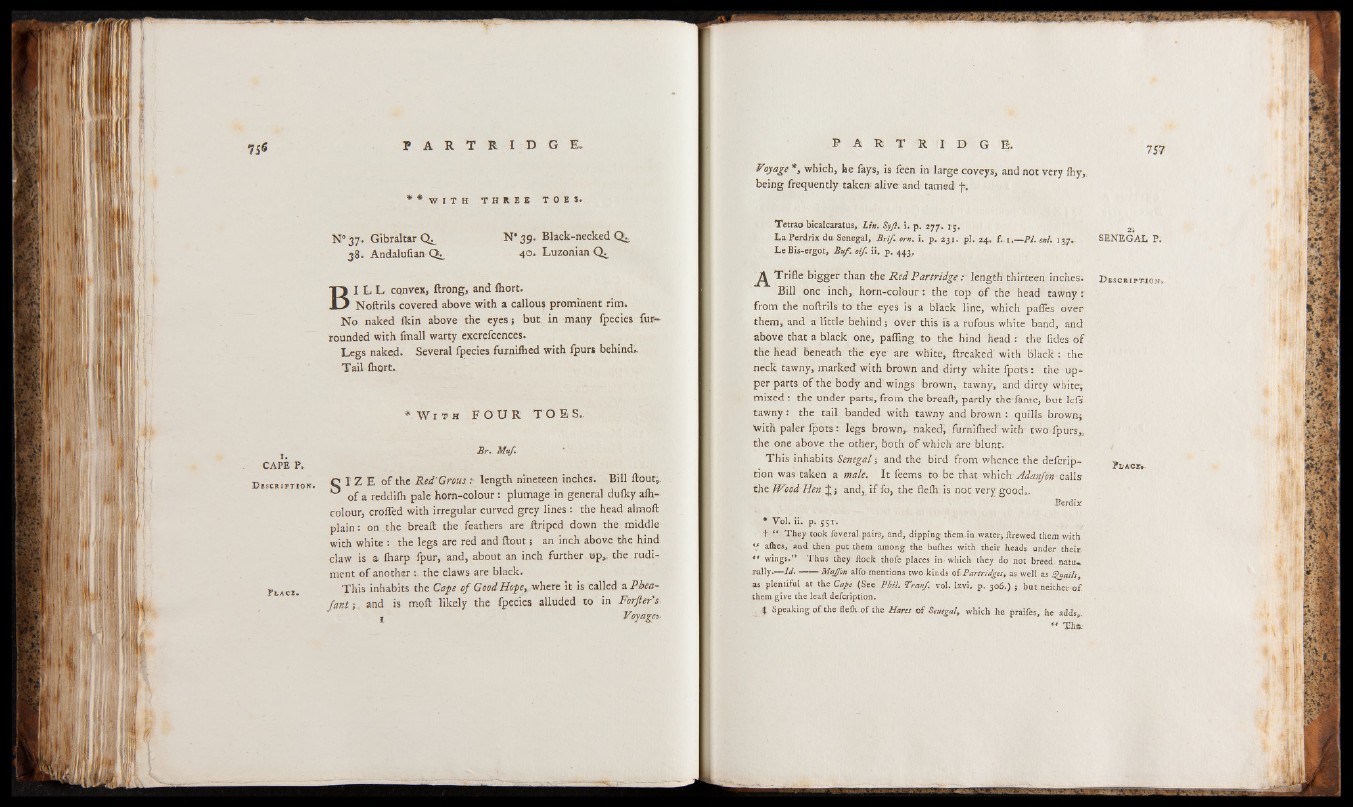
* * W I T H T H R E E TOE S .
N° 3 7 . Gibraltar Qi. N*39- Black-necked
38. AndalufianQ^ 4°- Luzonian Qj.
BI L L convex, ftrong, and fhort.
Noftrils covered above with a callous prominent rim.
No naked (kin above the eyes; but in many fpecies fur-
rounded with fmall warty excrefcences.
Legs naked. Several fpecies furnilhed with (purs behind».
Tail (hart..
’ W i t h F O U R T O E S . .
1.
CAPE P*
D e s c r i p t i o n *
Place.
Br. Muf.
Q I' Z E of the Red'Grous : length nineteen inches. Bill ftout;.
^ of a reddilh pale horn-colour: plumage in general dulky a(h-
colour, eroded with irregular curved grey lines: the head almoft
plain : on the bread the feathers are ftriped down the middle
with white : the legs are red and ftout; an inch above the hind
claw is a, (harp fpur, and, about an inch further up,, the rudiment
of another:. the claws are black.
This inhabits the Cap of Good H op, where it is called a Phea-
ja n t; and is mod likely the fpecies alluded to in Forjler’s.
t Voyage*-
m
Voyage *, which, he fays, is feen in large coveys, and not very Ihy,
being frequently taken alive and tamed f.
Tetrao bicalcaratus, Lin. Syji. i. p. 277. r j. 2;
La Perdrix du Senegal, BriJ. ont. i. p. 231. pi. 24. f . i ._PL ail. 137. SENEGAL P.
Le Bis-ergot, Buf. oif. ii. p. 443,
tk Trifle bigger than the Red Partridge: length thirteen inches; Descaii-mo»,
Bill one inch,, horn-colbur: the top of the head tawny:
from the noftrils to the eyes is a black line, which pafles over
them, and a little behind j over this is a rufous white band, and
above that a black one, palling to the hind head r the ftdes of
the head Beneath the eye are white, ftreaked with black : the
neck tawny, marked with brown and dirty white fpots: the upper
parts of the body and wings brown, tawny, and dirty white;
mixed : the under parts, from the bread, partly the fame, but lefs
tawny: the tail banded with tawny and brown ; quills brown;
With paler fpots : legs brown,, naked, furnifhed'with twofpurs,
the one above the other, both of which are blunt.
This inhabits Senegal-, and the bird from whence the deferip- ?t>A
tion was taken a male. It feems to be that which Adanfon calls
the Wood Hen J j and,, if fo, the fle(h is not very good-
Berdix
* Vol. ii. p. 55r.
t “ They took feveral pairs, and, dipping tKem-in.water> ftrewed them with
afhes, and then put them among the bufhes with their heads under their.
** wings.’* Thus they flock thofe places in- which they do not breed natu«.
rally.— Id .-----Majfott alfo mentions two kinds of.Partridges t as well as Quails,
as plentiful at the Cape (See Phil, <Tranf. vol. Ixvi. p. 306.) ; but.neither of
them give the leaft defeription.
t Speaking of. the flefh.of the Ham of Senegal, which he praifes, he adds,
“ The